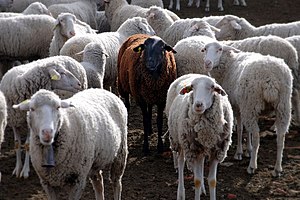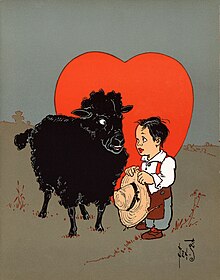The Original Black Sheep of the Family in the Forest

A black sheep stands out from the flock.

In the English language language, blackness sheep is an idiom used to draw a fellow member of a group, different from the rest, especially within a family, who does not fit in. The term stems from sheep whose fleece is colored black rather than the more than common white; these sheep stand out in the flock and their wool was traditionally considered less valuable equally it was non able to be dyed.
In large herds, black sheep are used because they contrast against the landscape improve than their white siblings. Unremarkably, one black sheep accompanies 100 white sheep in a flock of i,000 or more, and then that shepherds can easily count a flock.[ citation needed ]
The term has typically been given negative implications, implying waywardness.[i]
In psychology, the black sheep effect refers to the tendency of group members to judge likeable ingroup members more than positively and deviant ingroup members more negatively than comparable outgroup members.[ii]
Origin [edit]
In most sheep, a white fleece is not caused by albinism simply by a common ascendant gene that switches colour production off, thus obscuring whatsoever other color that may be present.[ commendation needed ] A black fleece is caused by a recessive gene, so if a white ram and a white ewe are each heterozygous for black, almost one in four of their lambs will exist black. In most white sheep breeds, but a few white sheep are heterozygous for black, so blackness lambs are usually much rarer than this.
Idiomatic usage [edit]
The term originated from the occasional black sheep which are built-in into a flock of white sheep. Black wool was considered commercially undesirable because information technology could not be dyed.[i] In 18th and 19th century England, the black color of the sheep was seen equally the marker of the devil.[3] In modern usage, the expression has lost some of its negative connotations, though the term is ordinarily given to the fellow member of a group who has sure characteristics or lack thereof accounted undesirable by that group.[iv] Jessica Mitford described herself equally "the red sheep of the family unit", a communist in a family of aloof fascists.[5]
The idiom is also institute in other languages, due east.1000. High german, French, Italian, Serbian, Bulgarian, Hebrew, Portuguese, Bosnian, Greek, Turkish, Hungarian, Dutch, Afrikaans, Swedish, Danish, Spanish, Catalan, Czech, Slovak, Romanian and Polish. During the Second Spanish Republic a weekly mag named El Be Negre, meaning 'The Black Sheep', was published in Barcelona.[6]
The same concept is illustrated in some other languages by the phrase "white crow": for case, belaya vorona ( бе́лая воро́на ) in Russian and kalāg-e sefīd ( کلاغ سفید ) in Persian.
In psychology [edit]
In 1988, Marques, Yzerbyt and Leyens conducted an experiment where Belgian students rated the following groups co-ordinate to trait-descriptors (due east.chiliad. sociable, polite, violent, cold): unlikeable Belgian students, unlikeable N African students, likeable Belgian students, and likeable Northward African students. The results indicated that favorability is considered highest for likeable ingroup members and lowest for unlikeable ingroup members, with the favorability of unlikeable and likeable outgroup members lying between the two ingroup members.[two] These farthermost judgements of likeable and unlikeable (i.e., deviant) ingroup members, relatively to comparable outgroup members is called "blackness sheep result". This effect has been shown in various intergroup contexts and under a variety of conditions, and in many experiments manipulating likeability and norm deviance.[7] [8] [9] [10]
Explanations [edit]

A prominent explanation of the blackness sheep upshot derives from the social identity approach (social identity theory[11] and self-categorization theory[12]). Group members are motivated to sustain a positive and distinctive social identity and, as a result, group members emphasize likeable members and evaluate them more than positive than outgroup members, bolstering the positive image of their ingroup (ingroup bias). Furthermore, the positive social identity may exist threatened by grouping members who deviate from a relevant group norm. To protect the positive group image, ingroup members derogate ingroup deviants more harshly than deviants of an outgroup (Marques, Abrams, Páez, & Hogg, 2001).[xiii]
In addition, Eidelman and Biernat showed in 2003 that personal identities are also threatened through deviant ingroup members. They argue that devaluation of deviant members is an private response of interpersonal differentiation.[xiv] Khan and Lambert suggested in 1998 that cognitive processes such as absorption and contrast, which may underline the effect, should exist examined.[9]
Limitations [edit]
Fifty-fifty though there is wide support for the black sheep effect, the reverse pattern has been found, for case, that White participants judge unqualified Black targets more negatively than comparable White targets (eastward.g. Feldman, 1972;[15] Linville & Jones, 1980).[16] Consequently, in that location are several factors which influence the black sheep effect. For instance, the higher the identification with the ingroup, and the higher the entitativity of the ingroup, the more the black sheep event emerges.[17] [18] Even situational factors explaining the deviance have an influence whether the black sheep issue occurs.[nineteen]
as a projection
To put information technology more precisely, a "black sheep" is an outsider who stands out due to characteristics or behavior that do non correspond to the ideas or rules that employ and are accepted in the grouping. This difference is rated as unpleasant past the other grouping members or felt equally "shameful". In doing so, people who are unlike are not only made responsible for their own behavior, simply as well generally blamed for grievances in the group.[two]
In the group dynamic, the "black sheep" in the role of the outsider fulfills an important function every bit a scapegoat. The group strengthens the inner cohesion at the expense of the outsider (bullying). Uncomfortable fearful group problems are kept out of the grouping past being projected and personified onto the outsider. The outsider is therefore a carrier of of import and valuable free energy and can - properly integrated - contribute significantly to the positive evolution of the group and its work.[three]
See also [edit]
- Black swan theory
- Glossary of sheep husbandry
- Scapegoat
- Baa Baa Blackness Sheep
- The Ugly Duckling
References [edit]
- ^ a b Ammer, Christine (1997). American Heritage Dictionary of Idioms . Houghton Mifflin Harcourt. p. 64. ISBN978-0-395-72774-4 . Retrieved 2007-eleven-13 .
- ^ a b Marques, J. M.; Yzerbyt, V. Y.; Leyens, J. (1988). "The 'Black Sheep Effect': Extremity of judgments towards ingroup members every bit a function of group identification". European Periodical of Social Psychology. 18: 1–sixteen. doi:ten.1002/ejsp.2420180102.
- ^ Sykes, Christopher Simon (1983). Blackness Sheep. New York: Viking Printing. p. 11. ISBN978-0-670-17276-4.
- ^ The American Heritage Lexicon of Idioms. Houghton Mifflin Visitor. 1992. Archived from the original on 2008-04-15. Retrieved 2008-03-24 .
- ^ "Red Sheep: How Jessica Mitford establish her voice" by Thomas Mallon 16 Oct 2007 New Yorker Archived 6 June 2011 at the Wayback Machine.
- ^ El be negre (1931-1936) - La Ciberniz Archived 2013-02-eleven at the Wayback Machine
- ^ Branscombe, N.; Wann, D.; Noel, J.; Coleman, J. (1993). "In-grouping or out-grouping extremity: Importance of the threatened social identity". Personality and Social Psychology Bulletin. 19 (4): 381–388. doi:10.1177/0146167293194003.
- ^ Coull, A.; Yzerbyt, V. Y.; Castano, Eastward.; Paladino, M.-P.; Leemans, 5. (2001). "Protecting the ingroup: Motivated allocation of cerebral resources in the presence of threatening ingroup members". Group Processes & Intergroup Relations. 4 (iv): 327–339. CiteSeerXx.ane.1.379.3383. doi:10.1177/1368430201004004003.
- ^ a b Khan, Due south.; Lambert, A. J. (1998). "Ingroup favoritism versus black sheep effects in observations of informal conversations". Basic and Practical Social Psychology. twenty (4): 263–269. doi:10.1207/s15324834basp2004_3.
- ^ Pinto, I. R.; Marques, J. M.; Levine, J. M.; Abrams, D. (2010). "Membership condition and subjective group dynamics: Who triggers the black sheep consequence?". Journal of Personality and Social Psychology. 99 (1): 107–119. doi:10.1037/a0018187. PMID 20565188.
- ^ Worchel, Due south.; Austin, W. G. (1979). The Social psychology of intergroup relations. Monterey, CA: Brooks-Cole.
- ^ Turner, J. C.; Hogg, M. A.; Oakes, P. J.; Reicher, S. D.; Wetherell, M. S. (1987). Rediscovering the Social grouping: A self-categorization theory. Oxford: Blackwell.
- ^ Hogg, 1000. A.; Tindale, S. (2001). Blackwell handbook of social psychology: group processes. Malden, Mass: Blackwell.
- ^ Eidelman, S.; Biernat, M. (2003). "Derogating black sheep: Individual or group protection?". Journal of Experimental Social Psychology. 39 (six): 602–609. doi:ten.1016/S0022-1031(03)00042-8.
- ^ Feldman, J. M. (1972). "Stimulus characteristics and discipline prejudice every bit determinants of stereotype attribution". Journal of Personality and Social Psychology. 21 (three): 333–340. doi:10.1037/h0032313.
- ^ Linville, P. W.; Jones, E. E. (1980). "Polarized appraisals of out-group members". Journal of Personality and Social Psychology. 38 (5): 689–703. doi:x.1037/0022-3514.38.5.689.
- ^ Castano, Due east.; Paladino, Thou.; Coull, A.; Yzerbyt, V. Y. (2002). "Protecting the ingroup stereotype: Ingroup identification and the direction of deviant ingroup members". British Periodical of Social Psychology. 41 (3): 365–385. doi:10.1348/014466602760344269. PMID 12419008. S2CID 2003883.
- ^ Lewis, A. C.; Sherman, S. J. (2010). "Perceived entitativity and the black-sheep upshot: When will nosotros denigrate negative ingroup members?". The Journal of Social Psychology. 150 (2): 211–225. doi:10.1080/00224540903366388. PMID 20397595.
- ^ De Cremer, D.; Vanbeselaere, N. (1999). "I am deviant, considering...: The affect of situational factors upon the black sheep effect". Psychologica Belgica. 39: 71–79.
External links [edit]
| | Look up black sheep in Wiktionary, the gratis lexicon. |
- Exploration of the etymology of the phrase "black sheep of the family"
- Marques, José Thousand.; José Chiliad. Marques; Vincent Y. Yzerbyt (1988). "The black sheep outcome: Judgmental extremity towards ingroup members in inter-and intra-group situations". European Journal of Social Psychology. 18 (3): 287–292. doi:10.1002/ejsp.2420180308. Retrieved 2008-01-04 .
Source: https://en.wikipedia.org/wiki/Black_sheep
Belum ada Komentar untuk "The Original Black Sheep of the Family in the Forest"
Posting Komentar